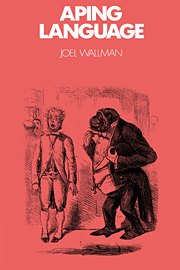Summary
The emergence of syntax, the combination of meaningful elements into propositions, is developmentally preceded by the solitary appearance of those elements themselves. In the child's development, as in human evolution, the advent of words – culturally forged markers for shared notions – confers the ability to convey the conceptions of one's mind to that of another, albeit imperfectly. In a very immediate way, the word allows us to control other people's minds, which provides a perverse but perhaps useful way of understanding the hackneyed observation that culture is based upon language. While nonverbal forms of communication, in our own and other species, can also be said to consist in this transfer of mental contents, words allow much greater precision in this, sentences an exquisite degree.
The first words, which seem to emerge out of nothing around the child's first birthday, do not, of course, appear ex nihilo. There is a developmental history to these earliest utterances, one that has been charted in great detail by Bates (1976,1979), Bloom and Lahey (1978), and Bruner (1983), to name just the Bs.
PRECURSORS OF THE WORD
Utter neonates are communicative to the extent that their vocalizations, gestures, and expressions convey information about their condition to caretakers. Though this communication may be unintended on the infant's part, it is effective in eliciting the kinds of nurturance that undoubtedly account for its having been naturally selected. Such controlled utterances are soon supplemented by still unconventional but intentional vocalizations and gestures. These articulations, which tend to accompany the child's taking notice of something, acquire a certain consistency in sound or appearance, although they are quite variable from one child to the next.
- Type
- Chapter
- Information
- Aping Language , pp. 49 - 78Publisher: Cambridge University PressPrint publication year: 1992



